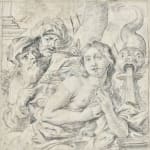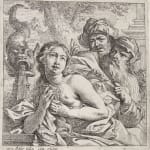Open a larger version of the following image in a popup:


Cornelis Schut, Susanna and the Elders, etching on laid paper.
Rijksmuseum, object no. RP-P-OB-59.180.
Cornelis Schut (Antwerp 1597 - 1655)
Susanna and the Elders
graphite and black chalk on laid paper
153 x 195 mm
Cornelis Schut was born in Antwerp in 1597. After probably training and working for a few years in the workshop of Peter Paul Rubens, he became a master of the...
Cornelis Schut was born in Antwerp in 1597. After probably training and working for a few years in the workshop of Peter Paul Rubens, he became a master of the Antwerp Guild of Saint Luke in 1618. Between 1624 and 1627 he lived in Rome, where he was one of the early members of the Bentvueghels, a local society of Flemish and Dutch artists. His nickname or “bentnaam” was ‘Brootsaken’ (‘bread bags’). In 1627-1628 the artist was in Florence, where he designed tapestries for the Arrazeria Medicea, the tapestry factory founded by Cosimo I de Medici. In the early 1630’s he returned to Antwerp.
In 1635 Schut collaborated on the decorations for the Royal Entry of the Cardinal-Infante Ferdinand in Antwerp, a project that was overseen by his former master Rubens. That same year, he was also commissioned to work on preparations for the Joyous Entry in Ghent. Schut collaborated on many other projects, alongside artists such as Gaspar de Crayer and Theodoor Rombouts. He painted the figures in many of Jan van Kessel’s flower garlands. Schut was regularly commissioned for altarpieces in churches and monasteries across the Southern Netherlands, but also further afield, such as in Cologne. In the Antwerp cathedral of Our Lady he painted the ceiling decoration of the dome, which depicts the Assumption of Mary; for the Antwerp Jesuit church he painted one of the four alternating altarpieces, the Ascension of Mary.
Stylistically, Schut was influenced by his contemporary Abraham Janssens, as well as by several Italian painters, such as Guercino and Guido Reni. Although he certainly borrowed motifs and stylistic elements from his master Rubens, the latter’s stylistic influence on Schut varied throughout Schut’s career, being strongest when Schut was in Antwerp for a longer period of time.
The present drawing is a design for a print (see ill. 1). Given their identical scale, the finely executed black chalk drawing of Susanna and the Elders was almost certainly used as the direct model for the print. A painted version is not known today, but it is by no means certain that it never existed and that this work was conceived as a print design from the outset. Traces of folds and sealing wax indicate that the artwork was once sent as a letter. Also, a strip of paper has been cut off, bearing a crossed-out and now unfortunately illegible inscription. Was this the address of a collaborator who was to etch the print? It was certainly not uncommon for printmakers to reside elsewhere and for designs, and later on the resulting printing plate, to be exchanged by messenger or by mail.


